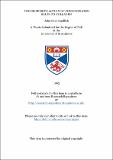Files in this item
The dispersive action of concentrated salts on collagen
Item metadata
| dc.contributor.advisor | Tristram, George Roland | |
| dc.contributor.author | Candlish, John Kerr | |
| dc.coverage.spatial | 159 p. | en_US |
| dc.date.accessioned | 2018-06-25T11:03:31Z | |
| dc.date.available | 2018-06-25T11:03:31Z | |
| dc.date.issued | 1963 | |
| dc.identifier.uri | https://hdl.handle.net/10023/14529 | |
| dc.description.abstract | 1. The literature concerning the dispersion off collagen by concentrated salt solutions has been reviewed; the literature concerning the reconstitution off native type collagen fibres has boon briefly reviewed, as has recent literature on the properties off the substrate for this work, calf skin collagen. 2. It has been shown that the dispersion off collagen by KI and CaCl2, involves, above a threshold concentration off salt, a highly reversible denaturation of the protein. 3. This denaturation has been shown to result in the dissociation off collagen into three subunits at various concentrations off salt. It has been proposed on the basis of these fractionations that the collagen employed consists off a population off units with varying degrees off resistance to depolymerisation, and therefore varying degrees off intramolecular cohesion. 4. It is considered that the available evidence favours as the mechanism off denaturation the reorientation off water in the solvent by KI or CaCl2 rather than the direct binding off salt molecules or ions to the protein. 5. Collagen fibres thermally reconstituted in the presence of various physiological substances have been shown to have different degrees of resistance to re-dispersion by KI and urea. Substances which appear to render the collagen more resistant are some anions, all amino acids tested, and L-ascorbic acid. 6. The effect of ascorbic acid and related substances on the resistance to re-dispersion of thermally reconstituted collagen has been studied in some detail and it is considered that the stabilising effect of this substance is due to its ionising enol grouping. The literature concerning a possible interaction of L-ascorbic acid with collagen in vivo has been reviewed and it has been proposed that the acid may have both an intracellular and extracellular function in repair tissue. 7. It has been demonstrated that non-protein nitrogen can be prepared from collagen in a number of ways, some of which do not involve extremes of pH or temperature throughout the entire manipulation of the collagen, Evidence for and against the assigning of a specific biological function to this non-protein nitrogen has been discussed. | en_US |
| dc.language.iso | en | en_US |
| dc.publisher | University of St Andrews | |
| dc.subject.lcc | QP551.C2 | |
| dc.subject.lcsh | General works, treatises, and textbooks | en |
| dc.title | The dispersive action of concentrated salts on collagen | en_US |
| dc.type | Thesis | en_US |
| dc.contributor.sponsor | Medical Research Scotland (MRS) | en_US |
| dc.type.qualificationlevel | Doctoral | en_US |
| dc.type.qualificationname | PhD Doctor of Philosophy | en_US |
| dc.publisher.institution | The University of St Andrews | en_US |
This item appears in the following Collection(s)
Items in the St Andrews Research Repository are protected by copyright, with all rights reserved, unless otherwise indicated.

